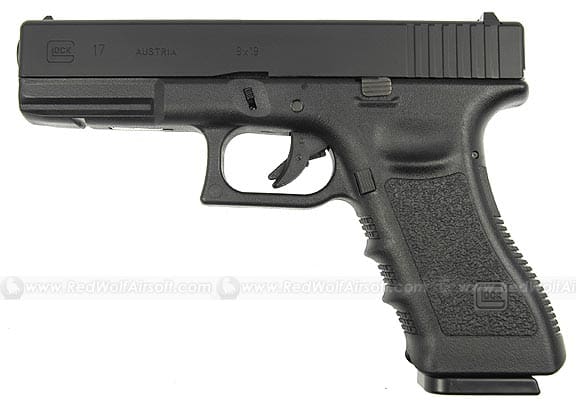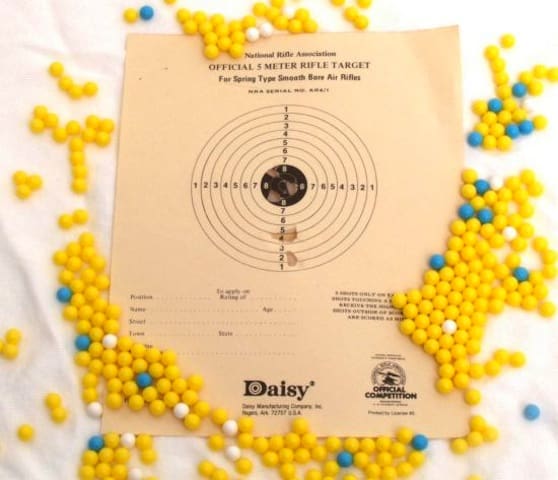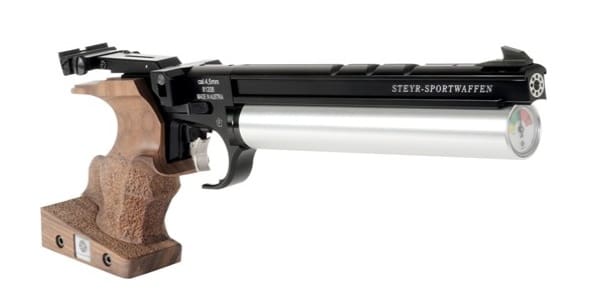For most shooters, regular live practice is impractical. Range fees, travel time, ammo cost and wear and tear on equipment render daily live fire practice economically impossible. Whether we’re talking about a firearms owner focusing on armed self-defense or a competitor at monthly club matches, most shooters never advance past the first year’s skills plateau because of insufficient practice. They read more articles and buy new firearms (and doodads for their firearms) but their skills and confidence stagnate. One solution: airgun practice . . .
A shooter determined to increase his or her skills can practice daily practice with a 15-30 foot target lane in a garage or apartment hallway, or a backyard for “run-and-gun.” Twenty minutes of air-gun trigger time several days a week will do wonders for your weekend match scores. In my opinion, most shooters disregard this practice method out of ignorance, arrogance, or machismo. High end air guns are not the children’s’ toys some shooters believe them to be.[1]
 Air guns have come a long way since the Red Ryder bb-gun. Air rifle and pistol are both Olympic sports[2], and those disciplines’ guns are some of the world’s most accurate[3]. Air gun sports are hugely popular in Europe. Many popular defensive firearms[4] have highly accurate air gun counterparts with spectacular triggers which are perfect for daily garage or backyard training. At short distances, a quality airgun will often shoot better minutes of angle than a comparable firearm, enabling meaningful practice on scaled targets.
Air guns have come a long way since the Red Ryder bb-gun. Air rifle and pistol are both Olympic sports[2], and those disciplines’ guns are some of the world’s most accurate[3]. Air gun sports are hugely popular in Europe. Many popular defensive firearms[4] have highly accurate air gun counterparts with spectacular triggers which are perfect for daily garage or backyard training. At short distances, a quality airgun will often shoot better minutes of angle than a comparable firearm, enabling meaningful practice on scaled targets.
Selecting an Airgun
Modern quality air guns are not inexpensive, and not available at Walmart or local sporting goods stores. Good models cost in the ballpark of comparable firearms, and are often imported. However, they typically hold their value as well as firearms, and like firearms, the more expensive models hold value better. There is an active used market on Internet forums, and used air guns are often a good option as airguns are less subject to wear and tear than firearms.[5]
The real economic savings from a high-end airgun purchase come from the savings on ammo, range fees, travel time, etc. Even Olympic grade lead pellets cost around $13 for 500[6], and for most purposes a $5 tin of 500 pellets will shoot just as well[7]. Airsoft plastic pellets are even cheaper.[8]
A serious challenge to a good air gun purchase is the lack of retailers in the US. For the most part, US buyers spend hundreds or thousands on quality airguns sight unseen, never handling the gun before purchase. This makes pre-purchase research critical, and fortunately several Internet forums are available with extensive reviews and community interaction.
Finding the right airgun for your needs requires serious homework. Do you want to practice one-handed Olympic or Bullseye pistol shooting?[9] Off hand rifle?[10] Airsoft IPSC simulations?[11][12] Do you want your exact carry gun replicated? Plan on spending many hours asking around on forums and reading reviews to figure out which types of high end airguns will work for you.[13]
Electronic Trainers
Primarily designed for slow-fire precision shooting sports, especially rifles, computerized training tools are simply amazing. Generally speaking, a system of sensors and receptors are mounted on your firearm’s barrel and a target down range, and an audio sensor for the hammer fall. These sensors feed data to software on your laptop. During a dry-fired shot, an amazingly accurate trace of the muzzle’s path is recorded on a laptop computer, along with an estimate of where the shot would have hit.
I use a Russian system called the SCATT to train for NRA High Power rifle, although the system is more popular among Olympic rifle shooters and Olympic air pistol shooters.[14] In the 15 feet space of my bedroom, I can practice off-hand, sitting and prone positions on scaled targets. The muzzle traces on the laptop provide me with invaluable information about my hold and reveal any problems with pulse, stability, and triggering errors.
I have probably taken upwards of 10,000 practice shots on the SCATT system in the two years I’ve owned it. Typically, I’ll practice off-hand for a half hour five or six days a week. I paid $1,000 for a used system, which obviously has paid for itself many times over in terms of ammo expense, range time, and replacement barrels. Plus, I’m at home practicing instead of the range, a system feature much appreciated by my wife. When done training for the day, everything easily stows hidden in the closet.
There are several electronic systems on the market.[15] They vary in price and features, but for many people the SCATT will be more than enough. Rapid fire is not an option, obviously, with any firearm requiring manual action cycling during dry fire.
“Shortcomings” of Airgun and Electronic Systems
Lack of stout recoil is the major difference between modern airguns and the “real steel” they mimic. For slow-fire disciplines, this is a non-issue. For rapid fire, although some gas Airsoft guns have mild “blowback” feature (approximate recoil of a .22LR), true recoil management is not fully simulated. Also, no air gun trigger will feel exactly like its firearm counterpart, but should still be good enough to practice the fundamentals of trigger technique. Further, the systems function much differently than real firearms, so failure drills are impossible.
Personally, I think many firearms owners overstate the significance of these differences as an excuse not to practice more often. Thousands of shooters use these off-range tools to improve their shooting with great success. Shooting practice is shooting practice. Concerns about developing bad habits with “fake” firearms are overstated.
Also, I typically will teach a new shooter to first shoot a co2 powered revolver before I have them try a .22LR pistol. They are a great way to build the learner’s confidence before putting a real firearm in their hands. After firing a realistic air gun well, the new shooter has no anxiety moving to the real firearm. Plus, it is a safer way to determine if the new shooter takes safety instruction well.
Conclusion
This article is just an overview of airgun and computerized training systems. The research required to make an informed decision on these training methods is daunting, but from personal experience I can confirm they are bona fide means to firearms mastery. The upfront costs may be intimidating, but consider the complete economic picture, especially ammo savings and resale value, before deciding that these “toys” are too expensive. Finally, these tools are not magic. If you don’t actually put in the time, they wont’ help.
[1]In fact, they are quite dangerous (most can take small rodents and birds) and should be treated with the same safety precautions as real firearms. Also, although legal in many states to shoot inside a private residence, make sure you check your local laws and ordinances, especially before you shoot one outdoors, even on private property.
[2]http://www.issf-shooting.org/. Be careful, it is easy to start with the idea of using one of these guns for practice, and then deciding you would rather compete with one as your primary discipline!
[3]http://jga.anschuetz-sport.com/index.php5?menu=102&sprache=1; http://www.pilkguns.com/worldclassap.shtml
[4]http://www.redwolfairsoft.com/redwolf/airsoft/Gas_Pistols_SMGs_Tokyo_Marui_Tokyo_Marui_G17_3rd_Generation.htm
[5]http://www.network54.com/Forum/79574/
[6]http://www.pyramydair.com/s/p/RWS_R_10_Match_Heavy_177_Cal_8_2_Grains_Wadcutter_500ct/288
[7]http://www.pyramydair.com/s/p/RWS_Diabolo_Basic_177_Cal_7_0_Grains_Wadcutter_500ct/234
[8]RedWolf Airsoft, a distributor, has been around a while and has an informative web site: http://www.redwolfairsoft.com/redwolf/airsoft/Beginners
[9]http://www.pilkguns.com/worldclassap.shtml
[10]http://www.pilkguns.com/sporterar.shtml; http://www.pilkguns.com/menu_ar15.shtml
[11]http://www.cedhk.com/shop/products/Airsoft-IPSC-%7B47%7D-IDPA-Paper-Targets.html
[12]http://www.airsoftforum.com/
[13]http://www.targettalk.org/; http://www.pyramydair.com/
[14]http://www.scatt.com/
[15]http://www.pilkguns.com/hometrainer.shtml; http://www.noptel.fi/eng/sport/index.php







The Steyr-Sportwaffen has the gauge facing the same way as the muzzle. So you have to point the barrel at your face to check the pressure. :S
Don’t knock the use of fake guns as a training aid… I’ve owned quite a few fake 1911s (Airsoft plastic ones, and Collector’s Armory metal ones) before getting a real one. The practice on the ersatz units helped make my administrative handling of my Kimber smooth and confident.
You could put your eye out with that thing.
Anyone interested just email me at either [email protected] or [email protected]. for some reason I can’t get emails from TTAG…so email me directly
Bought a Crosman 2240 a while back for just this purpose. Nice gun Co2, single shot, very accurate. I didn’t know at the time I had also purchased a cult gun of sorts.
http://airgunartisans.com/Crosman_2240.htm
My original comment saying which airguns I have if anyone would be interested is gone… o.O
This website is not Craig’s List. For both our readers’ safety and sanity.
Ok, no problem. Just thought I’d mention it due to the article
Honestly, even a cheap one can give you good trigger time. I ran Dot Torture all winter with a $50 M&P replica and an uncle mike’s holster. I saw huge improvements with my real carry piece when I went to the range the next spring. It’s not amazingly accurate, especially at range, but it’ll do a 2-3″ group at 7 yards. That’s plenty for most draw, press out, and transition drills. And five pop cans make a decent approximation of shooting steel.
The only advantage I see to getting a .22 pistol to save money over an air gun is that the .22 will be more accurate.. but at the cost of still needing to go to the range to shoot, and a higher overall cost.
Hi,
I am Jonathan Kent from Family sports and I was just going through your website and it’s quite stunning and comprehensive. I have a question for you: do you accept guest posts on your website? Because I am interested in such an opportunity. Please get back to me so we can discuss it.
Thanks
Comments are closed.